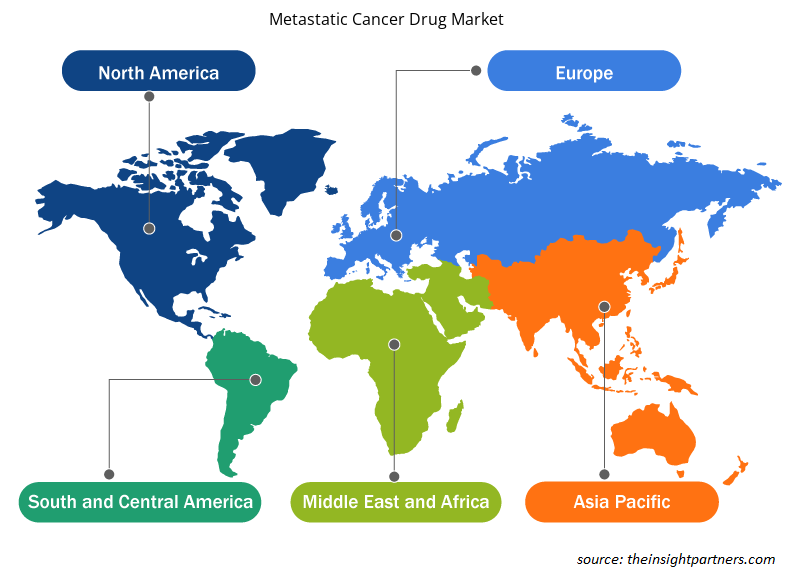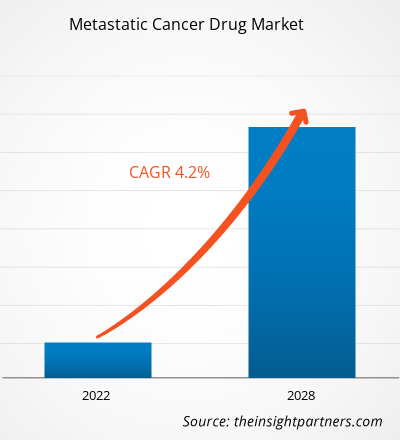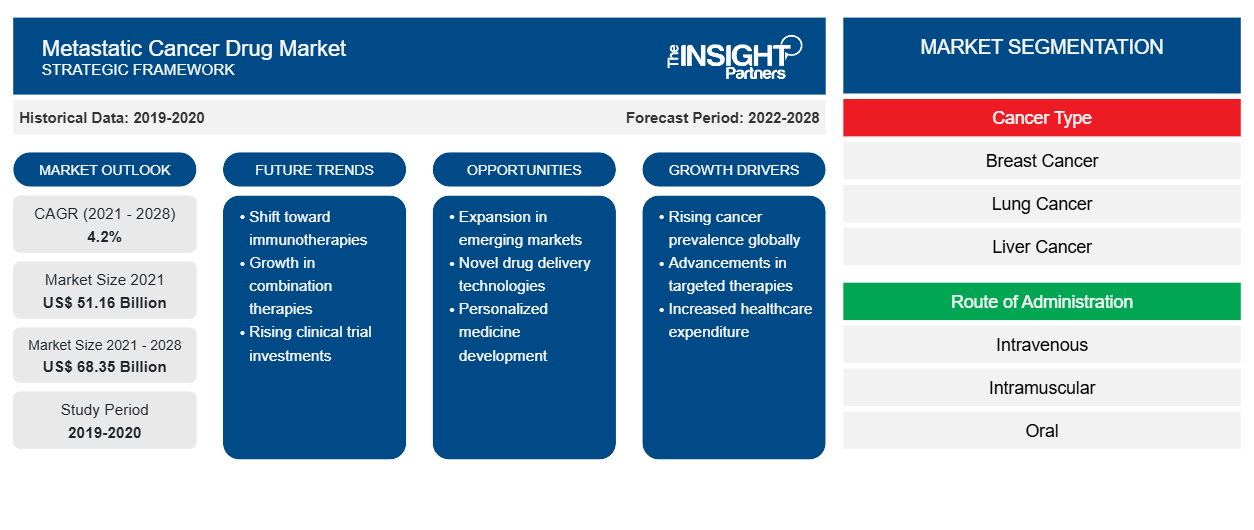[Rapporto di ricerca] Si prevede che il mercato dei farmaci contro il cancro metastatico raggiungerà i 68.349,54 milioni di dollari entro il 2028, rispetto ai 51.157,97 milioni di dollari del 2021. Si prevede che crescerà a un CAGR del 4,2% dal 2021 al 2028.CAGR of 4.2% from 2021 to 2028.
Il cancro metastatico è definito come un cancro in fase avanzata che si diffonde ad altre parti del corpo, e i farmaci usati per il trattamento del cancro in fase avanzata sono noti come farmaci per il cancro metastatico. Questi farmaci sono usati tramite varie terapie, come chemioterapia, immunoterapia e terapia mirata.
Il mercato dei farmaci per il cancro metastatico viene analizzato in base al tipo di cancro, alla via di somministrazione, alla classe di farmaci, al prodotto, all'utente finale e alla geografia. Il mercato, per geografia, è ampiamente segmentato in Nord America, Europa, Asia Pacifico, Medio Oriente e Africa e Sud e Centro America. Il rapporto offre approfondimenti e analisi approfondite del mercato, sottolineando i parametri, come le dimensioni del mercato dei farmaci per il cancro metastatico, le tendenze, i progressi tecnologici e le dinamiche di mercato, insieme all'analisi del panorama competitivo dei principali attori del mercato a livello mondiale.
Personalizza questo report in base alle tue esigenze
Riceverai la personalizzazione gratuita di qualsiasi report, comprese parti di questo report, o analisi a livello nazionale, pacchetto dati Excel, oltre a usufruire di grandi offerte e sconti per start-up e università
- Scopri le principali tendenze di mercato in questo rapporto.Questo campione GRATUITO includerà analisi di dati che spaziano dalle tendenze di mercato alle stime e alle previsioni.
Il mercato dei farmaci per il cancro metastatico è attribuito all'elevata prevalenza del cancro metastatico e alle iniziative governative per supportare gli sviluppi nel trattamento del cancro. Tuttavia, l'elevato costo dei farmaci oncologici limita la crescita del mercato dei farmaci per il cancro metastatico.
Market Insights
Alta prevalenza di cancro metastatico
Il cancro è una delle condizioni di salute che ha un impatto significativo sulle società in tutto il mondo. Secondo i dati forniti dal National Institute of Cancer, nel 2020, 1.806.590 persone soffrivano di cancro negli Stati Uniti, mentre 606.520 persone sono morte di cancro. Secondo l'American Institute of Cancer Research, nel 2020, 18.100 casi erano attivi in tutto il mondo. Inoltre, l'Organizzazione mondiale della sanità (OMS) ha affermato che 10.000 decessi, ovvero 1 su 6 decessi a livello globale, erano dovuti al cancro. I tipi di cancro più comuni sono il cancro ai polmoni, il cancro al seno, il cancro al colon, il cancro al retto e il cancro alla prostata. La condizione si sviluppa in 400.000 bambini ogni anno. Le infezioni cancerogene, tra cui Helicobacter pylori, virus dell'epatite B, papillomavirus umano (HPV), virus dell'epatite C e virus di Epstein-Barr, hanno causato il 13% dei casi di cancro nel 2018, a livello globale. L'Agenzia Internazionale per la Ricerca sul Cancro (IARC) prevede che il numero di nuovi casi di cancro e di decessi correlati al cancro in tutto il mondo crescerà di 1,6-1,7 volte entro il 2040, raggiungendo i 29,5 milioni e passando dai 16,4 milioni del 2018. Inoltre, secondo l'American Society of Clinical Oncology, nel 2021, 290.560 persone (287.850 donne e 2.710 uomini) negli Stati Uniti hanno ricevuto una diagnosi di cancro al seno invasivo. Il cancro al seno nelle donne ha ormai superato il cancro ai polmoni ed è riconosciuto come il tipo di cancro più comune al mondo. Circa 2.261.419 donne hanno ricevuto una diagnosi di cancro al seno nel 2020.papillomavirus (HPV), hepatitis C virus, and Epstein-Barr virus—caused 13% of cancer cases in 2018, globally. The International Agency for Research on Cancer (IARC) projects that the number of new cancer cases and cancer-related deaths worldwide will grow 1.6–1.7 fold by 2040 to reach 29.5 million and from 16.4 million in 2018. Further, according to the American Society of Clinical Oncology, in 2021, 290,560 people (287,850 women and 2,710 men) in the US were diagnosed with invasive breast cancer. Breast cancer in females has now surpassed lung cancer and is recognized as the most common cancer type worldwide. Approximately, 2,261,419 women were diagnosed with breast cancer in 2020.
Tra tutte le osservazioni registrate sul cancro negli Stati Uniti negli ultimi decenni, una statistica è rimasta invariata: il cancro metastatico rappresenta fino al 90% di tutti i decessi per cancro ogni anno. Questi numeri hanno motivato medici e ricercatori a trovare nuovi modi per trattare la metastasi, che si verifica quando il cancro si diffonde oltre il suo punto di origine. Negli Stati Uniti, il 6% delle donne ha ricevuto una diagnosi di cancro al seno metastatico alla prima diagnosi. Un tale aumento della prevalenza del cancro metastatico sta guidando la crescita del mercato dei farmaci contro il cancro metastatico.
In Nord America, si prevede che il Canada assisterà a una crescita considerevole nel periodo di previsione. I principali farmaci immunoterapici utilizzati in Canada sono ipilimumab (Yervoy), pembrolizumab (Keytruda), nivolumab (Opdivo), durvalumab (Imfinzi) e atezolizumab (Tecentriq). Tuttavia, ci sono altri inibitori dei checkpoint pronti a portare la crescita complessiva del mercato.immunotherapy drugs used in Canada are ipilimumab (Yervoy), pembrolizumab (Keytruda), nivolumab (Opdivo), durvalumab (Imfinzi) and atezolizumab (Tecentriq). However, there are other checkpoint inhibitors poised to bring the overall market growth.
Approfondimenti basati sul tipo di cancro
In base al tipo di cancro, il mercato dei farmaci per il cancro metastatico è segmentato in cancro al seno, cancro ai polmoni, cancro al fegato , cancro ematologico , cancro al cervello, cancro alla prostata, cancro al pancreas e altri. Il segmento del cancro al seno ha rappresentato la quota di mercato più grande nel 2021 e si prevede che registrerà il CAGR più elevato durante il periodo di previsione.CAGR during the forecast period.
Approfondimenti basati sulla via di somministrazione
In base alla via di somministrazione, il mercato dei farmaci per il cancro metastatico è segmentato in endovenoso, intramuscolare, orale e altri. Il segmento endovenoso ha rappresentato la quota di mercato maggiore nel 2021 e si prevede che registrerà il CAGR più elevato durante il periodo di previsione.
Approfondimenti basati sulla classe di farmaci
In base alla classe di farmaci, il mercato dei farmaci per il cancro metastatico è suddiviso in inibitori HER2, inibitori dei checkpoint immunitari , inibitori PARP, inibitori delle chinasi e altri. Il segmento degli inibitori PARP ha rappresentato la quota di mercato maggiore nel 2021. Tuttavia, si prevede che il segmento degli inibitori HER2 registrerà il CAGR più elevato durante il periodo di previsione.
Approfondimenti regionali sul mercato dei farmaci per il cancro metastatico
Le tendenze regionali e i fattori che influenzano il mercato dei farmaci per il cancro metastatico durante il periodo di previsione sono stati ampiamente spiegati dagli analisti di Insight Partners. Questa sezione discute anche i segmenti e la geografia del mercato dei farmaci per il cancro metastatico in Nord America, Europa, Asia Pacifico, Medio Oriente e Africa e America meridionale e centrale.

- Ottieni i dati specifici regionali per il mercato dei farmaci contro il cancro metastatico
Ambito del rapporto sul mercato dei farmaci per il cancro metastatico
| Attributo del report | Dettagli |
|---|---|
| Dimensioni del mercato nel 2021 | 51,16 miliardi di dollari USA |
| Dimensioni del mercato entro il 2028 | 68,35 miliardi di dollari USA |
| CAGR globale (2021 - 2028) | 4,2% |
| Dati storici | 2019-2020 |
| Periodo di previsione | 2022-2028 |
| Segmenti coperti | Per tipo di cancro
|
| Regioni e Paesi coperti | America del Nord
|
| Leader di mercato e profili aziendali chiave |
|
Densità degli attori del mercato dei farmaci per il cancro metastatico: comprendere il suo impatto sulle dinamiche aziendali
Il mercato dei farmaci per il cancro metastatico sta crescendo rapidamente, spinto dalla crescente domanda degli utenti finali dovuta a fattori quali l'evoluzione delle preferenze dei consumatori, i progressi tecnologici e una maggiore consapevolezza dei benefici del prodotto. Con l'aumento della domanda, le aziende stanno ampliando le loro offerte, innovando per soddisfare le esigenze dei consumatori e capitalizzando sulle tendenze emergenti, il che alimenta ulteriormente la crescita del mercato.
La densità degli operatori di mercato si riferisce alla distribuzione di aziende o società che operano in un particolare mercato o settore. Indica quanti concorrenti (operatori di mercato) sono presenti in un dato spazio di mercato in relazione alle sue dimensioni o al valore di mercato totale.
Le principali aziende che operano nel mercato dei farmaci per il cancro metastatico sono:
- AbbVie Inc.
- Società anonima Amgen Inc.
- Società Bristol-Myers Squibb
- F. HOFFMANN-LA ROCHE LTD.
- Novartis AG
Disclaimer : le aziende elencate sopra non sono classificate secondo un ordine particolare.

- Ottieni una panoramica dei principali attori del mercato dei farmaci per il cancro metastatico
Approfondimenti basati sui prodotti
In base al prodotto, il mercato dei farmaci per il cancro metastatico è diviso in branded e generici e biosimilari. Il segmento branded ha rappresentato una quota di mercato maggiore nel 2021. Tuttavia, si stima che il segmento generici e biosimilari registrerà un CAGR più elevato durante il periodo di previsione.
Informazioni basate sull'utente finale
In base all'utente finale, il mercato dei farmaci per il cancro metastatico è segmentato in ospedali, cliniche specialistiche e altri. Il segmento ospedaliero ha rappresentato la quota maggiore nel 2021, mentre si stima che il segmento delle cliniche specialistiche registrerà il CAGR più elevato durante il periodo di previsione.
I lanci e le approvazioni di prodotti sono tra le strategie comunemente adottate dalle aziende per espandere la propria presenza globale e i portafogli di prodotti. Gli operatori del mercato dei farmaci per il cancro metastatico si concentrano anche sulla strategia di partnership per ampliare la propria clientela, il che, a sua volta, consente loro di mantenere il proprio marchio in tutto il mondo. Mirano a far crescere le proprie quote di mercato con lo sviluppo di prodotti innovativi.
AbbVie Inc.; Amgen Inc.; Bristol-Myers Squibb Company; F. HOFFMANN-LA ROCHE LTD.; Novartis AG; ASTRAZENECA PLC.; Eli Lilly and Company; MERCK KGaA; e Pfizer Inc. (Arena Pharmaceutical GmbH); e Johnson and Johnson Services, Inc. sono le aziende leader che operano nel mercato dei farmaci contro il cancro metastatico.
- Analisi storica (2 anni), anno base, previsione (7 anni) con CAGR
- Analisi PEST e SWOT
- Valore/volume delle dimensioni del mercato - Globale, Regionale, Nazionale
- Industria e panorama competitivo
- Set di dati Excel
Report recenti
Rapporti correlati
Testimonianze
Motivo dell'acquisto
- Processo decisionale informato
- Comprensione delle dinamiche di mercato
- Analisi competitiva
- Analisi dei clienti
- Previsioni di mercato
- Mitigazione del rischio
- Pianificazione strategica
- Giustificazione degli investimenti
- Identificazione dei mercati emergenti
- Miglioramento delle strategie di marketing
- Aumento dell'efficienza operativa
- Allineamento alle tendenze normative





















 Ottieni un campione gratuito per - Mercato dei farmaci per il cancro metastatico
Ottieni un campione gratuito per - Mercato dei farmaci per il cancro metastatico